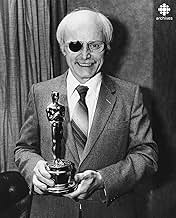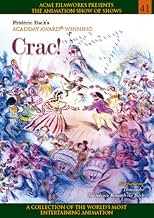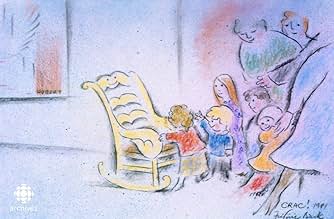Crac
- 1980
- 15m
IMDb RATING
7.4/10
1.7K
YOUR RATING
The industrialization of Montreal (Canada), as seen from the point of view of a rocking-chair.The industrialization of Montreal (Canada), as seen from the point of view of a rocking-chair.The industrialization of Montreal (Canada), as seen from the point of view of a rocking-chair.
- Director
- Writer
- Won 1 Oscar
- 3 wins total
Featured reviews
"Crac" is beautifully animated short following the life and creation of a rocking chair. It is a testament to the power of visual story telling. The short is an excellent pairing of charming colored pencils sketches and wonderful thematically appropriate music. The story reminds me of Shel Silverstein's "The Giving Tree". The impact this tree and this chair had on the life of this man his family and future generations. This could also be seen as a precursor of Pixar projects. The idea of giving emotion to the inanimate object can lead to some sweet and thoughtful moments. Overall, this is a very charming and likable short, and I will try to keep my thoughts on it likewise.
10llltdesq
This short, one of the most deserving winners of the Academy Award in its category that I've had the pleasure of seeing, is simply magnificent, Excellent idea, wonderful animation and music, marvelous pacing and transitions, just glorious on all counts! The ending is perfect! Frederic Back made at least three other shorts besides this one and I truly wish I could find any or all of them in-print on VHS. So far as I know, they've never been available in the United States. *SIGH* Well, Crac is in print, at least. Most completely and joyously recommended.
Moving images evoke emotions in a manner still frames don't, at least for me. Paintings have always eluded my sense of appreciation because I don't receive signals that would take me into their world. In moving images do I get solace because they visibly attempt at delivering their message. It is the lustrous moving images in Crac that made me cry and fall in love with the beautiful and enchanting world it depicts.
The story is about a craftsman who makes a rocking chair for his love, and after they get married keeps the rocking chair at home while the couple becomes a family with the arrival of children (and plenty of them). The chair is a mute witness to their lives, as it changes from growing green to ripening red and finally fading yellow.
If you look at the Storyline section in IMDb, it says Crac is about the industrialization of Montreal as seen from the view of a rocking chair. This description seems too literal and banal and would discourage youngsters from watching the short. To me, Crac is the celebration of human life in the wonderful, advancing world symbolized in the form of a swaying rocking chair. More than the event, it is the human experience that counts; if we disregard the human aspect that concomitantly progresses in order to adapt to changing circumstances, than we remain narrow-minded. Frederick Back, like the literary stalwart Leo Tolstoy, has enmeshed history and humanity with more poignancy but using hand drawn Impressionistic strokes instead of words, than most modern Pixar films can do with spectacular life-like animation.
Frederic Back's mind works like Walt Disney's as both visualize the world in a profoundly imaginative way. Watch a Walt Disney short and you may find a living train panting and tugging the rail tracks to reach the destination. Similarly, in Crac, the crib inside which a child is play acting turns into the car he imagines. Also, minimalistic paintings come alive and dance surreally in the art gallery. Only a childlike mind could show the images so beautifully without making the action seem corny or saccharine. There are delightful and ingenious moments in Crac, for example, the dance sequence during the marriage where at first, only the craftsman and his wife begin after which a third character magically appears from behind and then the entire space is filled with happy couples. Also wonderful is the dreamy sequence of sheep in the sky when the mother is putting her kids to sleep. And the spectacular moment at the art gallery after the curator leaves. Or even the tiny bit in the beginning where the craftsman proposes to the lady and she blushes, and her upper body looks like a heart. But the most striking part is Back's observation of children. In the art gallery, while the adults in their expensive clothes try to make sense out of abstract works, the children are lured by this simple rocking chair, and a ride on it puts a big smile on their faces. Also commendable is the use of music and sounds, which mainly consist of folk music, the echoing sound of a child's laughter, the switch, the bursting bubble gum etc.
I'm borrowing Robert Christgau's words to describe Crac in a nutshell: 'Frederic Back's Crac evinces a remarkable resemblance to care- that is to care, that is to caring in the best, broadest, most emotional sense.' Tell whoever you know to watch it.
My Rating: 5 out of 5
The story is about a craftsman who makes a rocking chair for his love, and after they get married keeps the rocking chair at home while the couple becomes a family with the arrival of children (and plenty of them). The chair is a mute witness to their lives, as it changes from growing green to ripening red and finally fading yellow.
If you look at the Storyline section in IMDb, it says Crac is about the industrialization of Montreal as seen from the view of a rocking chair. This description seems too literal and banal and would discourage youngsters from watching the short. To me, Crac is the celebration of human life in the wonderful, advancing world symbolized in the form of a swaying rocking chair. More than the event, it is the human experience that counts; if we disregard the human aspect that concomitantly progresses in order to adapt to changing circumstances, than we remain narrow-minded. Frederick Back, like the literary stalwart Leo Tolstoy, has enmeshed history and humanity with more poignancy but using hand drawn Impressionistic strokes instead of words, than most modern Pixar films can do with spectacular life-like animation.
Frederic Back's mind works like Walt Disney's as both visualize the world in a profoundly imaginative way. Watch a Walt Disney short and you may find a living train panting and tugging the rail tracks to reach the destination. Similarly, in Crac, the crib inside which a child is play acting turns into the car he imagines. Also, minimalistic paintings come alive and dance surreally in the art gallery. Only a childlike mind could show the images so beautifully without making the action seem corny or saccharine. There are delightful and ingenious moments in Crac, for example, the dance sequence during the marriage where at first, only the craftsman and his wife begin after which a third character magically appears from behind and then the entire space is filled with happy couples. Also wonderful is the dreamy sequence of sheep in the sky when the mother is putting her kids to sleep. And the spectacular moment at the art gallery after the curator leaves. Or even the tiny bit in the beginning where the craftsman proposes to the lady and she blushes, and her upper body looks like a heart. But the most striking part is Back's observation of children. In the art gallery, while the adults in their expensive clothes try to make sense out of abstract works, the children are lured by this simple rocking chair, and a ride on it puts a big smile on their faces. Also commendable is the use of music and sounds, which mainly consist of folk music, the echoing sound of a child's laughter, the switch, the bursting bubble gum etc.
I'm borrowing Robert Christgau's words to describe Crac in a nutshell: 'Frederic Back's Crac evinces a remarkable resemblance to care- that is to care, that is to caring in the best, broadest, most emotional sense.' Tell whoever you know to watch it.
My Rating: 5 out of 5
This French-Canadian film is simply gorgeous--like a moving tapestry. For the time it was made, this was a standout film that begged to be noticed for both its artistic styling as well as the fascinating history lesson contained within.
The film begins with a chair being built long, long ago. As the years passed and life changed around the chair, it's all shown in a magically lyrical manner--with lovely folk music, dancing and visuals.
To me, this is a film that tries to encapsulate the entire pioneering spirit and link it to today. It achieves it spectacularly and is well worth seeking out--since, unfortunately, the film is practically forgotten today even though it did receive the Oscar for Best Animated Short in 1982.
The film begins with a chair being built long, long ago. As the years passed and life changed around the chair, it's all shown in a magically lyrical manner--with lovely folk music, dancing and visuals.
To me, this is a film that tries to encapsulate the entire pioneering spirit and link it to today. It achieves it spectacularly and is well worth seeking out--since, unfortunately, the film is practically forgotten today even though it did receive the Oscar for Best Animated Short in 1982.
Le Rêve Du Diable, the folk group, was expertly chosen to reawaken the feeling of those times of early French Canadian settlers....pioneers who lived WITH, not in spite of, the New Land. The music interlocks and enhances the film like a puzzle piece, joining the art with the activism...and especially with the proud traditions of the Québécois! The swirling of memories was appropriately used as a powerful metaphor to conjure the long-gone past...still very much alive in the Hearts of those who understand the need to keep the flame burning. I recall the first time I saw this film in a smallish theater where a compilation of award-winning short films and animations was presented. It brought a tear to my eye...it was so full of sentiment and love for the natural primeval beauty of the land. I have experienced the "before and after" of overpopulation and excessive, unnecessary pressure on habitats. In my case it was practically like the Joni Mitchell song "...they paved Paradise, put up a parking lot"!
Did you know
- TriviaThe only word in this film that is clearly visible and not distorted is its title, when the tree falls in the beginning.
- ConnectionsFeatured in Animated Century (2003)
Details
Contribute to this page
Suggest an edit or add missing content



















